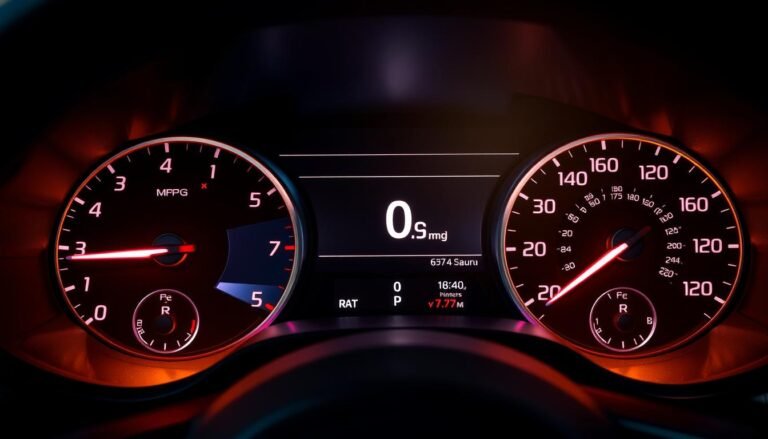Subaru Crosstrek Tire Pressure Guide & Tips
What’s the best tire pressure for your Subaru Crosstrek tire pressure? It’s generally around 34 psi for the best performance.
Keeping the right tire pressure is crucial for safety, saving fuel, and keeping your car running smoothly. Having the correct tire pressure improves control and stability.
It also makes braking quicker and keeps tires cool to avoid punctures. Whether you’re on a family trip or commuting, the right tire pressure saves fuel and enhances your drive.
It’s okay to raise the pressure to 38 psi when your car is fully loaded. This guide will give you key info and tips for maintaining your Subaru Crosstrek’s tires.
You’ll learn how to check tire pressure and understand tire upkeep. By the end, you’ll know how to keep your tire pressure perfect and adjust it when needed.
What is Tire Pressure Basics?
Tire pressure is crucial for safe and efficient driving. It helps your tires last longer. Knowing about tire pressure can improve your drive, save fuel, and keep you safe.
Importance of Tire Pressure
Proper tire pressure is vital. If tires are under-inflated, they use more fuel. Over-inflated tires might lose grip, risking blowouts. The right pressure keeps tires working best, ensuring safety and good handling.
How Tire Pressure Affects Performance?
Correct tire pressure impacts your car’s performance directly. Tires with wrong pressure wear out unevenly. This can mess with your car’s balance and control. Check your pressure regularly for better fuel use and tire life.
Subaru suggests checking and rotating your tires every 6 months or 6,000 miles. This prevents uneven wear. It’s very important for cars with Symmetrical All-Wheel Drive.
Optimal Tire Pressure For Subaru Crosstrek
It’s key to know the right tire pressure for your Subaru Crosstrek for safety and the car’s best performance. The proper tire pressure affects how the car handles, its gas mileage, and how long the tires will last.
It’s very important to learn the recommended PSI for different situations and how adjusting the tire pressure with the seasons can help your car perform better.
Recommended PSI Levels
For a Subaru Crosstrek, the best tire pressure is 33 PSI in the front tires and 32 PSI in the back ones when they’re cold. If you drive a Subaru Crosstrek Hybrid, then you should keep the tires at 34 PSI.
If your car is carrying more weight, you can increase the pressure to 38 PSI for the best results. These PSI levels make sure your tires work well and keep you safe on the road.
Adjusting For Seasonal Variability
Tire pressure changes with the temperature. You should adjust your tire pressure by 1 PSI for every 10 degrees Fahrenheit change.
During cold months, the pressure in your tires might drop, which could make your car handle poorly and wear out your tires faster.
Changing the tire pressure with the seasons keeps you safe, makes your car more comfortable to drive, and helps with gas mileage.
Always check your tire pressure, especially before long drives or when the season changes, to keep the right pressure in your Subaru Crosstrek.
| Subaru Model | Front Tire Pressure (PSI) | Rear Tire Pressure (PSI) |
|---|---|---|
| Crosstrek | 33 | 32 |
| Crosstrek Hybrid | 34 | 34 |
| Forester | 36 | 35 |
| Outback | 35 | 33 |
| BRZ | 35 | 35 |
| Ascent | 35 | 35 |
| Impreza | 33 | 32 |
| Legacy | 33 | 32 |
| WRX | 33 | 32 |
Where To Find Subaru Crosstrek Tire Pressure Details?
It’s important to keep your Subaru Crosstrek running right. For this, you need the right tire pressure. You can find this info in two key spots: the doorjamb and the owner’s manual.
The doorjamb information gives correct tire pressure for your car. And the owner’s manual has more tips and advice to help you out.
Doorjamb Information
Open the driver’s door on your Subaru Crosstrek and check the doorjamb. You’ll find a sticker there. It tells you the Subaru Crosstrek tire pressure details you need, like how much PSI your tires should have. This keeps your car running smoothly and safely.
Owner’s Manual Guidance
Looking in your Subaru Crosstrek’s owner’s manual is another smart move. It agrees with the doorjamb about PSI levels and tells you extra things.
Things like how to take care of your tires and adjust for different weather. This keeps your car working well and your tires lasting longer.

How To Check Subaru Crosstrek Tire Pressure?
Keeping the right tire pressure is key for your Subaru Crosstrek’s performance and safety. It’s good to know how to use a tire pressure gauge for checking it. Make sure to check when conditions are right.
Using a Tire Pressure Gauge
A tire pressure gauge can accurately measure your tires’ air pressure. Here’s what to do:
- Park on a flat surface and wait for the tires to cool. This could be before driving or after sitting for hours.
- Take off the valve cap from the tire you’re checking.
- Push the gauge onto the valve stem tightly to get a reading.
- Write down the measurement from the gauge.
- See if the number matches the recommended pressure: 33 PSI in front and 32 PSI back when cold.
- If needed, add or let out air using an air compressor or tire inflator.
- Put the valve cap back on firmly.
When To Check Tire Pressure?
It’s critical to know the best times to check your tire pressure. Here are some tips:
- Do it monthly.
- Check before a long trip.
- Check after big temperature changes, as a 10 degrees Fahrenheit drop can change pressure by 1 PSI.
- Tires should be cold for the most accurate readings.

Subaru Crosstrek Tire Pressure Monitoring System
The Subaru Crosstrek has a smart tire pressure checking system. It watches tire pressure and tells you if it’s too low. This keeps you safe and makes sure your car runs well.
It’s important to know how this system works to keep your Crosstrek in good shape.
How TPMS Works?
The Subaru Crosstrek uses a direct TPMS with sensors in each wheel. These sensors send tire data to the car’s computer using radio waves. If tire pressure is too low or high, a light on your dashboard turns on.
This tells you something needs to be checked. Tire pressure can drop when it gets colder, by about 1 PSI for every 10 degrees. So, keeping an eye on tire pressure is extra important when it’s cold outside.
Signs of a TPMS Malfunction
If the TPMS warning light stays on, there might be a problem. A flashing light that then stays on could mean a system issue.
If your dashboard shows wrong tire info, or warnings that don’t match your tires’ actual situation, the TPMS may need a professional look.
Keeping up with maintenance and check-ups helps avoid these problems and keeps your car safe.

Common Issues with Subaru Crosstrek Tire Pressure Light
The Subaru Crosstrek tire pressure light is very important. It tells you when your tire pressure is too low. Knowing about this alert helps keep your car running smoothly and safely.
This light can turn on for many reasons. It means you should check your tires as soon as possible. Below, we’ll look at common reasons this light comes on and how to fix them.
Knowing Tire Pressure Alerts
Your Subaru Crosstrek has a system that checks tire pressure. When the pressure drops by 25%, the light turns on. You should check your tire pressure yourself every month.
The best pressure is between 32 and 38 PSI. Doing this keeps the warning light off by making sure the pressure is right.
Troubleshooting Tire Pressure Light Activation
If the tire pressure light doesn’t go off after you’ve checked and filled your tires, try these steps:
- Recheck your tire pressure: Make sure it matches the recommended levels (33 PSI for the front, 32 PSI for the rear).
- Look for leaks: Sometimes, leaks aren’t easy to spot. Check for any cuts or things stuck in the tire.
- Check TPMS sensors: If your tires are fine and there are no leaks, the sensors may be the problem. They usually work for about 10 years or 100,000 miles.
- Get a professional check: If you still have issues, it’s best to go to a service center for a full check-up.

Maintaining Subaru Crosstrek Tire Pressure
Keeping the right tire pressure in your Subaru Crosstrek is key for top vehicle performance and safety. By following regular tire care steps, you can dodge problems like tire wear and bad vehicle handling.
A steady tire maintenance routine will make your tires last longer and ensure a safe, fun driving experience.
Regular Maintenance Practices
To handle your Subaru Crosstrek safely and effectively, you should do these maintenance tasks regularly:
- Routine tire pressure checks: Checking your tire pressure once a month is important. For most Subaru Crosstrek models, the ideal tire pressure is between 32-36 PSI.
- Visual inspections: Often look for wear or damage signs like cracks or bulges.
- Tire rotation: Subaru recommends rotating your tires every 6,000 to 7,500 miles to help tires wear evenly.
- Using a pressure gauge: You can quickly check tire pressure with a gauge. Do this check in the morning before driving to get the most accurate reading.
- Penny test for tread depth: Use a penny to check tread depth; if you can see Lincoln’s head, your tire needs replacing.
Seasonal Tire Pressure Adjustments
Adjusting your Subaru Crosstrek’s tire pressure for the season is crucial. Tire pressure drops about 1 PSI for every 10°F decrease in temperature.
On the flip side, in hot weather, tire pressure might go up, which can cause over-inflation. Keep an eye on the Tire Pressure Monitoring System (TPMS) light.
If it turns on because of a seasonal pressure drop, it’s time to check and adjust your tire pressure. Keeping your tire pressure steady prevents uneven tread wear and related safety issues.
Subaru Crosstrek Tire Pressure Reset Process
Resetting the Tire Pressure Monitoring System (TPMS) light in your Subaru Crosstrek helps keep it safe and performing well.
After putting air in your tires to the right amount, it’s key to reset the TPMS light. This ensures it tracks your tire pressure correctly from then on.
Steps To Reset The TPMS Light
Follow these simple steps to reset the tire pressure in a Subaru Crosstrek:
- Use a pressure gauge to check the air in all four tires. Make sure the front tires have 33 PSI and the rear ones 32 PSI.
- If you’ve added air, drive your Crosstrek at more than 20 MPH for about 10-15 minutes. This lets the TPMS update and reset.
- Look at the TPMS light on the dash. If it goes out, the reset worked. If it stays on, you might need to do more.
- A blinking light means there could be something wrong with the TPMS. You might need extra help to find out what’s wrong.
When To Seek Professional Help?
If the TPMS light stays on after you try to reset it, there might be a bigger problem. This could be from faulty sensors, a TPMS battery dying after 5-10 years, or other hidden issues.
Getting professional help fast makes sure any serious problems are fixed. This keeps you safe and your Subaru Crosstrek running right.
| Action | Description |
|---|---|
| Check Tire Pressure | Ensure tires are inflated to the proper PSI (33 front, 32 rear). |
| Drive the Vehicle | Maintain speed above 20 MPH for 10-15 minutes. |
| Observe TPMS Light | Check if the light turns off after driving. |
| Contact a Professional | If issues persist, consult a mechanic for diagnostics. |
Tips For Keeping Your Subaru Crosstrek Tires Healthy
It’s key to keep your Subaru Crosstrek tires in top shape for safety and vehicle performance. Using the right care methods can make your tires last longer and save gas.
Paying regular attention to the condition of your tires also makes for a smoother ride and better handling.
Routine Inspections and Adjustments
Set up a regular schedule to check your tires. Look for uneven wear, cracks, or any signs of damage that could make driving risky.
It’s good to check tire pressure once a month to spot any issues early. Since tire pressure drops when it gets colder, by about 1 PSI for every 10°F drop, keep an eye on it.
For the best performance, keep the front tires at 33 PSI and the back at 32 PSI. This helps your car drive better.
Choosing The Right Tires For Your Crosstrek
When you need new tires, picking the right ones for how and where you drive is very important. Think about the roads you drive on, the weather, and what you like.
The right tires offer better grip and make driving safer. Subaru also suggests rotating your tires every 6,000 to 7,500 miles. This keeps the wear even and makes them last longer.
Make sure the tires you choose fit what the manufacturer recommends. They should be able to handle your Crosstrek’s performance needs.
| Inspection Aspect | Recommended Action |
|---|---|
| Tire Pressure Check Frequency | At least once a month |
| Optimal Front Tire Pressure | 33 PSI |
| Optimal Rear Tire Pressure | 32 PSI |
| Recommended Tire Rotation Interval | Every 6,000 to 7,500 miles |
| Potential Pressure Loss in Winter | Up to 10 PSI |
Conclusion
Keeping your Subaru Crosstrek’s tire pressure right is key for the best performance and safety. Checking tire pressure often helps tires last longer and saves fuel.
Even being 10 PSI off can lower fuel efficiency by 3%. Learn how the tire pressure monitoring system (TPMS) works in your Crosstrek.
Use tools like the Bartec Tech600Pro for correct readings. This way, you avoid problems like galvanic corrosion or faulty sensors.
Stick to the advised tire pressures. This is important especially with changing seasons. Proper tire pressure means better driving, comfort, and safety on any road.
FAQs
What is the optimal tire pressure for a Subaru Crosstrek?
For a Subaru Crosstrek, set the front tires to 33 PSI and the back tires to 32 PSI when they’re cold.
How do I check the tire pressure on my Subaru Crosstrek?
To check your tire pressure, you’ll need a gauge. Make sure the tires are cold. Then, remove the valve cap and press the gauge onto the stem. Finally, read the pressure on the gauge.
What should I do if the tire pressure light comes on in my Subaru Crosstrek?
First, check all four tires’ pressures. Inflate any that are low to the right PSI. If the light stays on, there could be a puncture or a sensor issue. You might need to get professional help.
How often should I check my Subaru Crosstrek tire pressure?
You should check your tire pressure at least once a month and before any long trips. This keeps your car running safely and efficiently.
How does the Tire Pressure Monitoring System (TPMS) work in my Subaru Crosstrek?
The TPMS keeps an eye on your tire pressure. If a tire’s pressure goes too low, it will alert you with a dashboard light.
Can weather affect my Subaru Crosstrek tire pressure?
Yes, temperature changes can affect tire pressure. You should adjust the pressure by 1 PSI for every 10-degree Fahrenheit change in weather.
How can I reset the TPMS light on my Subaru Crosstrek?
Correct the tire pressure, then drive over 20 mph for a few minutes to reset the TPMS. If the light stays on, you may need to see a professional.
What are common signs of TPMS malfunction?
If the warning light stays on after fixing the tire pressure, or if the dashboard readings are off, the TPMS might be malfunctioning.







